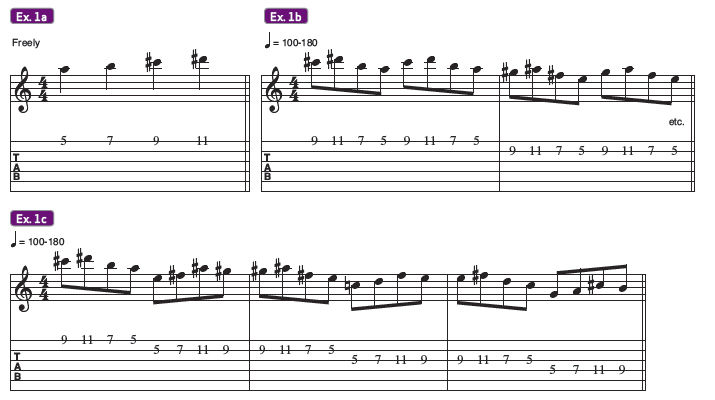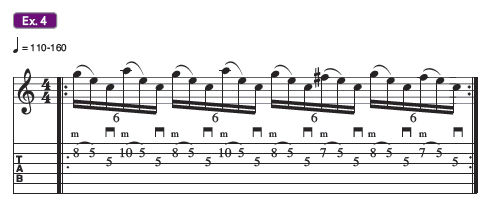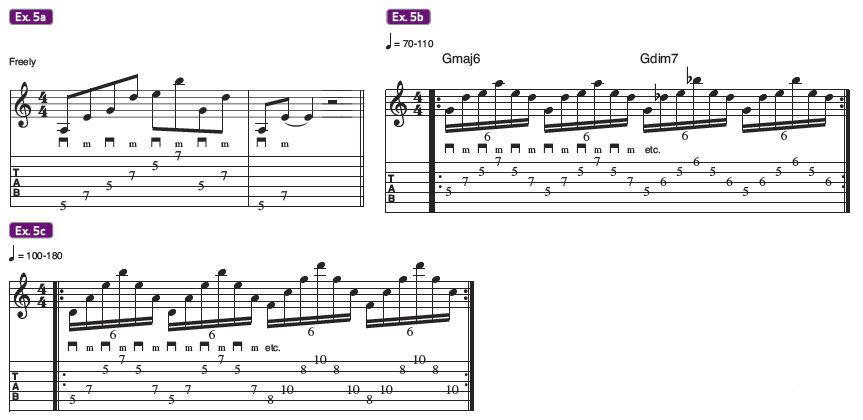Pick Up Some of Vernon Reid’s Abstract Fretboard Logic
Go on a heady fretboard odyssey of wide intervallic leaps, quasi-atonality, and unorthodox applications of hybrid picking.

Considering he’s christened his New York homestead “The Abstract Ranch,” it’s a good bet a face-to-face lesson with Vernon Reid might go beyond garden variety blues, rock, or bebop licks. Sure enough, the veteran jazz-punk/metal-funk alchemist treats GP readers to a heady fretboard odyssey of wide intervallic leaps, quasi-atonality, and unorthodox applications of hybrid picking in this lesson.
“I like to view the guitar neck as a grid,” says Reid, “with an infinite number of ways to navigate, aside from just standard position scales or arpeggios. One strategy I’ve been using lately is to develop ideas around a series of successive whole tones on one string [Ex. 1a].
"Here, the series is A, B, C#, D#, starting on the fifth fret of the first string, but you can move the sequence up or down the neck to the position where you just begin to feel the stretch in your fingers.
"From this starting point, you’re able to develop different one-string patterns and then play them across all six strings [Ex. 1b], or take two separate patterns – one per string – and track them across two-string pairs [Ex 1c].

“A further expansion of this four-successive-steps-on-a-string idea involves grabbing a pattern of chromatic half-steps [Ex. 2a] then alternating it with the same sequence, only in whole tones [Ex. 2b].
"I find that this particular exercise makes a great warm-up, since you’ll most likely feel tension and release in your fretting hand while shifting back and forth between the half- and whole-steps.

"A somewhat more musical application of this idea, however, is to play the sequence with a halfstep, whole-step, half-step (A, Bb, C, Db) note spacing [Ex. 3a]. It sounds great over an Adim7 or A7b9 chord, especially if you sequence it in minor third increments by shifting up the neck with your first finger, three frets each time [Ex. 3b].
All the latest guitar news, interviews, lessons, reviews, deals and more, direct to your inbox!

“Another element I’ve begun introducing into my playing is the use of hybrid picking to play across string pairs. For example, we can take a whole-step, half-step, wholestep sequence of notes starting from the 5th fret of the B string (E, F#, G, A) and play a pattern against the C on the 5th fret of the G string [Ex. 4].
"This lick can be performed entirely with a plectrum, but I find I get a much smoother sound by alternating downstrokes on the G string with plucked notes from my middle or ring finger on the B string. Once I became more proficient at this technique, I was able to play single notes across all the strings with a fluidity I couldn’t get by flatpicking alone.

"I particularly like playing perfect fifths across string pairs [Ex. 5a] or alternating between perfect and diminished fifths [Ex. 5b]. Start this last run from the G note on the 5th fret of the fourth string, and you’re essentially outlining a G6 to Gdim7 chord change.
"Finally, I find using the hybrid-picking approach makes string skipping much easier to negotiate, so for even wider intervallic leaps try starting the pairs of fifths on the fifth string, 5th fret D note, skip the G string, then sequence the whole pattern up a minor 3rd [Ex. 5c].
“As many of these examples are tonally ambiguous, you can try working them into your playing over altered dominant chords or improvisations with static tonal centers. They can also serve as a departure point for your own exploration by getting you to think more abstractly, discovering your own shapes and patterns that are outside the box of traditional scales and harmony.”

